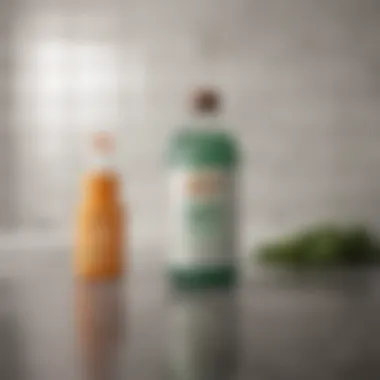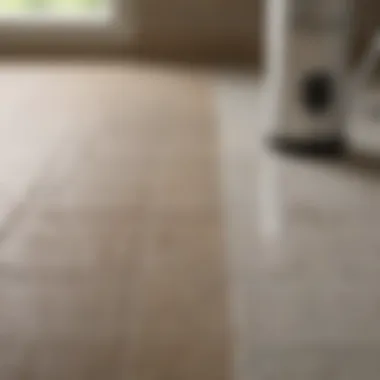Effective Techniques for Cleaning White Grout


Intro
Maintaining the cleanliness of white grout can be a challenge for many homeowners. The porous nature of grout makes it susceptible to stains, mold, and dirt accumulation. Understanding how to clean white grout effectively can greatly enhance the appearance of tiled surfaces, ensuring that they remain bright and appealing.
In this guide, we will explore various methods for cleaning white grout, including both natural and commercial solutions. Each technique will be accompanied by practical tips and insights, allowing readers to choose the best approach tailored to their specific needs.
We will delve into the necessary ingredients, detailed cleaning procedures, and preventive strategies against future stains. This comprehensive examination will empower readers to maintain the integrity and aesthetics of white grout, ultimately improving the overall look of their living spaces.
Prolusion to White Grout
White grout is an essential component in many tiled surfaces, prized for its clean, elegant appearance. In this article, we aim to explore the best practices for cleaning white grout, an often overlooked yet critical aspect of home maintenance. The brighter the grout, the more striking the overall look of the tiles. Therefore, understanding how to maintain it is vital.
Understanding Grout Composition
Grout is primarily made from a mixture of cement, water, and potentially other additives. This combination allows it to provide strength and stability to tile installations. White grout, specifically, typically uses white cement, which contributes to its light color. The porous nature of grout makes it susceptible to stains, dirt, and mildew, especially in high moisture areas like kitchens and bathrooms. The composition is designed for durability, but without proper care, it can become discolored and unsightly. A thorough understanding of how grout is made can aid homeowners in making informed decisions about cleaning methods and products.
Common Challenges with White Grout
Many homeowners encounter typical issues with white grout that impede its aesthetic appeal. One major challenge is its tendency to absorb stains from spills and everyday use. Food residue, dirt, and soap scum can create a dull or darkened appearance, contradicting the initial brightness of the grout.
Another common issue is mold and mildew growth, particularly in humid environments. These can turn into persistent problems if not addressed promptly. Regular exposure to moisture can facilitate this growth, making timely cleaning indispensable. Finally, the fragility of the grout also raises concerns; using harsh scrubbing tools or abrasive solutions can result in damage, leading to additional repairs and costs.
Understanding these challenges is the first step in developing an effective cleaning methodology. By knowing what makes white grout so appealing yet challenging, readers are better equipped to implement the best cleaning practices.
Signs your Grout Needs Cleaning
Understanding when your grout needs cleaning is crucial to maintaining its appearance and integrity. Grout, particularly white grout, can become discolored and dirty over time due to various factors. The need for cleaning is not just about aesthetics. Dirty grout can harbor bacteria and mold, posing health risks. Thus, recognizing the signs that indicate grout cleaning is essential for both health and maintenance.
Visual Indicators of Deterioration
Visual clues serve as prominent indicators of grout's condition. Some common signs include:
- Color Changes: White grout may show yellowish or grayish hues. These discolorations often arise from dirt accumulation or mold growth.
- Cracked Grout Lines: Cracks can indicate that the grout is degrading. If these cracks are evident, they might lead to water intrusion and further damage.
- Surface Stains: Stains may be localized around heavily trafficked areas or near fixtures like sinks, toilets, and bathtubs.
Regular inspection can help identify a need for cleaning before conditions worsen.
Odors and Stains
Odors can be a clear sign that your grout is in need of immediate attention. If you notice a musty, damp smell in your tiled areas, this is a strong indication of mold or mildew development. The presence of these microorganisms may not always be visible, but they can significantly affect indoor air quality.
In addition to odors, visible stains are another sign of unclean grout. This may include dark spots or smudges that do not seem to wash away with normal cleaning. Such stains are often the result of spills, foot traffic, or soap scum build-up. Stains can ultimately lead to permanent discoloration if not treated promptly.
"Detecting these signs early can save you from extensive cleaning efforts later on."
Promptly addressing these indicators can help maintain not only the appearance but also the durability of your grout. Ensuring it stays clean also prevents potential mold issues and health risks.
Preparation for Cleaning


Cleaning white grout effectively begins long before any cleaner touches the tile surface. Preparation is vital for ensuring the chosen methods realize their fullest potential. When homeowners pre-emptively organize their approach, they lower the risk of ineffective treatments and enhance overall results. This section will outline what needs to be done before diving into the cleaning process.
Gathering Necessary Supplies
Before starting, it is crucial to gather all necessary cleaning supplies to streamline the process. Consider both natural and commercial options available in the market. Here are some important items to have on hand:
- Scrub Brushes: Use brushes with firm bristles to aid in effective scrubbing.
- Cleaning Solutions: Depending on preference, you can choose baking soda, vinegar, hydrogen peroxide, or commercial enzyme-based cleaners. Also, be attentive to the specific instructions on product labels.
- Protective Gear: Gloves and a mask protect the skin and respiratory system, especially when using harsher chemicals.
- Buckets and Rags: These will be important for rinsing and drying, ensuring the area remains clean during the process.
Obtaining the right tools and materials can significantly affect how well the grout cleaning session goes.
Assessing the Area
Taking the time to evaluate the grout and tiles is an important step that should not be overlooked. Understanding the extent of stains or damage will help to select the most effective cleaning approach. Here are some factors to consider during assessment:
- Stain Severity: Check if stains are surface-level or deeper. Heavy stains may require more aggressive methods.
- Grout Condition: Look at the integrity of the grout itself. If it appears damaged or crumbling, it might need repair before cleaning.
- Tile Material: Different tile materials react differently to various cleaning products. For example, natural stone surfaces need special care.
Assessing these elements before starting can save time and effort later in the process.
Methods for Cleaning White Grout
Cleaning white grout can significantly enhance the appearance of tiled surfaces. Grout, being porous, tends to absorb dirt and stains over time. Therefore, selecting the right method to clean it is crucial for achieving desired results. There are different approaches available, both natural and commercial. Understanding their effectiveness allows homeowners to make informed decisions that cater to their specific needs.
Natural Cleaning Solutions
Natural cleaning solutions are a popular choice for those seeking environmentally friendly options. They are often safer to use, both for human health and the planet. Here are three effective natural methods:
Baking Soda and Vinegar
Baking soda and vinegar is a classic combination known for its cleaning power. These two ingredients react with each other, creating a fizzing action that can help lift dirt and stains from grout. The primary characteristic of this solution is its accessibility; both baking soda and vinegar are common household items. This method is beneficial because it allows homeowners to clean without resorting to harsh chemicals.
However, using baking soda and vinegar may have limitations. While effective on light stains, this method might not tackle deeper embedded dirt as efficiently as stronger solutions might. It is best utilized for routine cleaning and maintenance rather than severe discolored grout.
Hydrogen Peroxide Mixture
Hydrogen peroxide is another effective cleaning agent. Its unique aspect is that it functions as an oxidizer that can break down stains and dirt effectively. Many homeowners choose this option for its disinfectant properties. This makes it very suitable for areas such as bathrooms and kitchens where hygiene is paramount.
The advantage of hydrogen peroxide lies in its ability to whiten grout effectively. However, it can cause discoloration on some surfaces if not carefully used. Thus, it is essential to do a spot test before applying it broadly throughout an area.
Dish Soap and Warm Water
A simple mixture of dish soap and warm water offers a gentle yet effective cleaning option. The key characteristic of this approach is its mildness; it does not contain abrasive chemicals that might damage grout. It is a popular choice for those looking for a quick daily cleaning solution without significant investment in cleaning supplies.
The unique feature of using dish soap and warm water is that it can easily dissolve grease and surface dirt. However, this method could fall short on tougher stains or deeply ingrained dirt that require more potent cleaning solutions.
Commercial Products
For those who prefer options that require less effort or target stubborn stains, commercial products provide a viable alternative. These products are specifically designed to address the complexities of cleaning grout. Here are some notable options:
Enzyme-Based Cleaners


Enzyme-based cleaners contain biological enzymes that break down organic stains and dirt. Their effectiveness comes from their ability to target specific types of grime, such as food stains or mold. This characteristic makes them a beneficial choice for various settings, especially in kitchens and bathrooms.
The unique feature of these cleaners is their environmentally friendly nature, as many are biodegradable. However, they may require some time to work effectively, signaling to users that patience can be essential in achieving the desired result.
Grout Pens and Sealants
Grout pens provide a quick fix for discolored or stained grout lines. Their primary characteristic is convenience; they allow users to cover imperfections easily. Homeowners often find these pens beneficial for minor restorations without extensive cleaning.
However, it is important to note that grout pens may not address underlying dirt effectively; they mainly serve to improve appearance. Over time, the effectiveness of the coating may diminish, requiring reapplication.
Bleach Solutions
Bleach solutions are among the strongest options available for cleaning grout. They can tackle tough stains and mildew effectively. The appeal of bleach lies in its ability to provide quick results, making it a popular choice for immediate cleaning needs.
However, the unique downside of bleach solutions is their potential to cause discoloration or damage to some tiled surfaces. Their strong odor is also a consideration for users, emphasizing the need for adequate ventilation during use.
Ultimately, every cleaning method has its place. Understanding the strengths and weaknesses of each will lead to more successful grout maintenance.
Step-by-Step Cleaning Process
The step-by-step cleaning process is crucial to effectively maintaining white grout. This section outlines clear methods to achieve satisfactory results. Each step is designed to tackle dirt, stains, and discoloration while ensuring grout integrity. A systematic approach prevents damage and enhances the overall aesthetic of tiled areas.
Initial Application
The initial application sets the stage for effective grout cleaning. Begin by selecting a suitable cleaning solution. For natural methods, options such as baking soda mixed with vinegar or hydrogen peroxide are often preferred due to their non-toxic qualities. On the other hand, commercial products offer a more robust solution for stubborn stains.
When applying the cleaner, it is essential to cover all grout lines thoroughly. Using a spray bottle or a sponge can be useful for this purpose. Aim for an even application to ensure consistent results. Allow the cleaner to sit for a determined period. This waiting time facilitates the break down of dirt and grime.
Scrubbing Techniques
Scrubbing techniques can significantly influence the effectiveness of the cleaning process. A soft-bristle brush is generally advised for most tiles, as it will remove debris without eroding the grout. For more persistent stains, consider using a medium-bristle brush, but always test in an inconspicuous area first.
Adopt a circular motion during scrubbing, as this method helps lift dirt from the porous surface. It is also essential to maintain a consistent pressure. Applying too much force can damage the grout, while too little may not effectively clean it. Regularly rinse your brush in clean water to avoid redistributing dirt back onto the surface.
Rinsing and Drying
Rinsing and drying are the final steps that can determine the success of your cleaning endeavor. Once scrubbing is complete, thoroughly rinse the area with clean water. This action removes any residual cleaner or dirt. Using a mop or sponge can aid in this process, ensuring that all remnants of cleaning solutions are eliminated.
After rinsing, ensure the area is well-ventilated for drying. If possible, use a fan or keep windows open to increase air flow. Avoid walking on the freshly cleaned surface until it is entirely dry. This practice prevents new dirt from settling on the grout.
In summary, a methodical approach to the cleaning process is key to maintaining the beauty and longevity of white grout.
Employing the strategies discussed above allows for a successful cleaning outcome, opening pathways for preventive measures in the future.
Preventative Maintenance for Grout
Preventative maintenance for grout is essential to prolong the lifespan and aesthetic appeal of tiled surfaces. White grout is particularly prone to discoloration and staining, making its upkeep imperative. Establishing an effective maintenance plan not only addresses immediate concerns but also mitigates future problems, saving time and money in the long run. Adopting simple practices can significantly enhance the longevity of grout, providing homeowners with clean and presentable areas.


Regular Cleaning Schedule
Implementing a regular cleaning schedule is a key component in maintaining the appearance of white grout. Routine cleaning prevents the buildup of dirt, mold, and mildew, which can become entrenched in the porous surface of grout. Ideally, it is advisable to clean grout on a monthly basis, depending on foot traffic and exposure to moisture.
Here are some steps to consider for a regular cleaning regime:
- Monthly Deep Cleaning: Dedicate time each month to conduct a thorough cleaning using either natural products or commercial cleaners. Focus on areas prone to stains, such as kitchens and bathrooms.
- Quick Wipes: On a weekly basis, use a mild cleaner or vinegar solution to wipe down tiled surfaces. This prevents grime from settling and becoming more difficult to remove later.
- Spot Treatment: Address spills or stains immediately to avoid permanent marks. The sooner action is taken, the easier it will be to remove these blemishes.
Using Grout Sealant
Utilizing grout sealant is another vital preventive measure in grout maintenance. Sealants create a protective barrier on the surface, which helps in repelling water and stains. By preventing moisture from penetrating the grout, sealants reduce the risk of mold growth and staining.
When considering sealant application, keep these points in mind:
- Frequency of Application: Grout should be sealed every 6 to 12 months, depending on the product used and wear and tear of the area. Make sure to check manufacturers’ recommendations for best results.
- Proper Application: Ensure the grout is clean and dry before sealing. Apply the sealant evenly, avoiding over-application which could lead to a tacky finish.
- Testing for Effectiveness: After sealing, it is good practice to test the grout with a few drops of water. If water beads up, the sealant is working. If it absorbs, reapplication may be necessary.
"Regular maintenance and the use of high-quality sealants are crucial for keeping white grout looking fresh and clean over time."
By implementing a regular cleaning schedule and taking advantage of grout sealants, homeowners can maintain their tiled surfaces with minimal effort and maximum effectiveness.
Common Mistakes to Avoid
Cleaning white grout can be a challenging task. Understanding common mistakes makes a significant difference in achieving optimal results. Many homeowners unknowingly damage their grout by following incorrect practices. Awareness of these missteps can save time, effort, and potential costs. Thus, this section combines insights that enhance grout maintenance strategies and ensure better outcomes.
Over-Aggressive Scrubbing
Homeowners often believe that scrubbing harder will yield cleaner grout. However, over-aggressive scrubbing can harm the grout itself. Many types of grout contain porous materials, which are susceptible to wear and tear. Excessive force can cause scratches and lead to discoloration or even cracking.
Using stiff bristle brushes is sometimes tempting, but they are not always the best choice. Soft-bristled brushes or scrubbers provide enough friction for cleaning without causing damage.
Additionally, an effective cleaning solution helps minimize scrubbing efforts. Saturating the grout with a cleaner and letting it sit for a few minutes softens the dirt. Then, gentle scrubbing will be more effective. It is crucial to prioritize the method and tools used rather than brute force.
"Gentle cleaning methods preserve the integrity of your grout and keep it looking new longer."
Incompatible Cleaning Products
Choosing the wrong cleaning products is another frequent mistake. Many people opt for products that are too harsh for their grout. For example, acidic cleaners can erode grout, particularly if it is cement-based. They can lead to deterioration, make stains worse, and necessitate more frequent repairs.
Some commercial products designed for tile floors can do more harm than good. It is key to read labels and ensure compatibility with the type of grout installed. Enzyme-based cleaners are generally a safer choice, as they break down stains without damaging the grout.
Testing any new product in a small, inconspicuous area helps gauge its effect on the grout. If discoloration occurs, stop using the product immediately. Selecting the right cleaner helps to maintain the appearance and longevity of your grout, ensuring your cleaning efforts remain effective over time.
The End
Cleaning white grout effectively is a task that requires both understanding and careful execution. The cleanliness of grout not only impacts the aesthetic of tiled areas but also influences overall hygiene within a household. This article has shed light on various cleaning methods, each with its own unique approach and effectiveness.
Summary of Key Points
- Understanding Grout: Grout is a porous material prone to staining, especially in white color. It is essential to comprehend its composition to choose appropriate cleaning methods.
- Recognizing Cleaning Needs: Signs like discoloration or unpleasant odors are indicators that your grout needs attention. Prompt cleaning helps maintain its integrity.
- Preparation is Key: Gathering all necessary supplies and assessing the area to be cleaned can streamline the process and ensure efficient outcomes.
- Diverse Cleaning Methods: Both natural and commercial options exist. Baking soda combined with vinegar or enzyme-based cleaners are effective choices, each catering to different preferences.
- Avoiding Common Pitfalls: Many mistakes can hinder cleaning efforts, including over-scrubbing or using products that react poorly with grout.
Final Thoughts on Grout Maintenance
Maintaining white grout is an ongoing commitment. Regular cleaning routines and the application of grout sealants significantly enhance longevity and appearance. Homeowners should prioritize light maintenance tasks that can prevent major stains and degradation. Having the right knowledge of both natural and commercial cleaning solutions opens doors to options that can fit various lifestyles and preferences.
Ultimately, a well-maintained grout improves the overall visuals of tiled surfaces while contributing to a cleaner living environment. Thus, understanding effective cleaning strategies for grout is essential for any homeowner.







